When taking on any length triathlon, especially the Ironman, it would be heartbreaking to find out you did something that disqualified you from the race.
Today, we want to inform you about the swim leg of the Ironman Triathlon so you have the knowledge to take on the 2.4-mile Ironman swim. We will be going over what kind of swim stroke is best and how to perform the stroke correctly.
Legal Swim Strokes for the Ironman
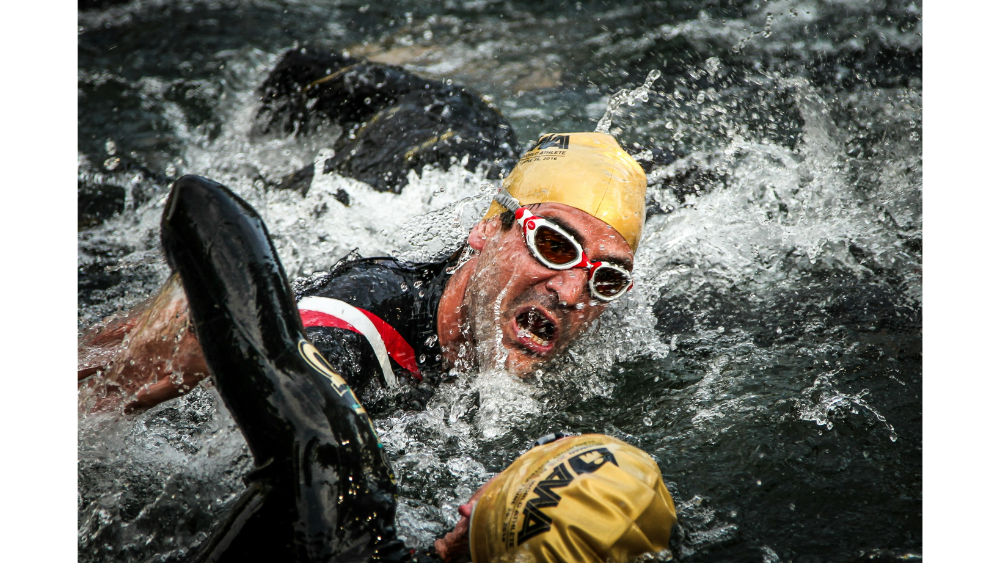
The ONLY stroke that is allowed is… all of the swimming strokes. Ironman does not have a rule against swimming freestyle, breaststroke, backstroke, or butterfly. It comes to what is more efficient for the swimmer and they decide what stroke they would like to do. If your Ironman or triathlon event has a rule against a certain stroke, they will inform you.
In a triathlon swim, it has been noted that when some swimmers go to their back it may indicate the swimmer needs help, so do avoid swimming backstroke if you can.
The top two strokes used during the Ironman are the freestyle stroke and breaststroke. Let’s break down both of these strokes and analyze which one is better!
Freestyle Stroke
The freestyle stroke, also known as the front crawl, is the most popular stroke used in the Ironman Triathlon swimming portion. This is my personal favorite stroke for long-distance swimming.
Swimming freestyle is the easiest to learn and is the most efficient and fastest stroke from start to finish. Freestyle swimming will take you farther and faster than breaststroke will.
Breaststroke
Swimming breaststroke may not be as popular as the freestyle stroke in competitive swimming, but it still has its advantages. This stroke is less intense and can be more energy-efficient compared to the freestyle stroke. It also allows the swimmer to have greater visibility for navigation and breathing during an open-water swim.
In open-water swimming, it will be easier to slow down and take a moment to catch your breath while still progressing forward during your race when swimming breaststroke. Many racers, when they begin to feel tired will slow down and swim breaststroke.
How to Swim Freestyle Correctly
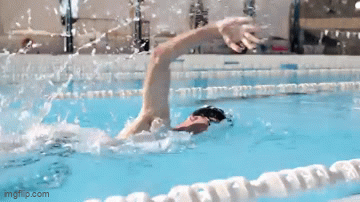
We want to make sure that you have the best swimming technique for your race! Here is what you can focus on so you can achieve proper form. Combine these tips and you will see an increase in your swimming speed.
1 | Body Position
The body should remain flat and streamlined in the water, with the head positioned in a straight line with the spine. The face is typically looking down or slightly forward to reduce drag.
A horizontal body position helps minimize resistance, allowing the swimmer to glide more smoothly through the water. Keeping the hips and legs close to the surface is crucial for maintaining speed and efficiency.
2 | Arm Movement
The freestyle stroke involves a continuous and alternating arm and leg movements that is divided into four phases:
1 | Entry and Catch: The hand enters the water in front of the head, fingers first, and reaches forward. The catch phase begins when the hand and forearm start pressing down and backward against the water to generate propulsion.
2 | Pull and Push: This is the power phase, where the arm pulls through the water in an “S” shape, moving from the catch position near the water’s surface to the push phase, which ends when the hand reaches the hip. Don’t push the water down but behind you to propel your body forward.
3 | Recovery Phase: The arm exits the water and swings forward in a relaxed manner to re-enter for the next stroke. Proper recovery minimizes energy expenditure and maintains rhythm.
4 | Kick: The freestyle kick is an alternating flutter kick, through each stroke cycle, using the hips and legs to generate propulsion at the beginning and to keep balance through the race. The toes should be pointed, and the legs should remain relatively straight for maximum efficiency.
3 | Stroke Rate, Count, and Length
Stroke Count: The number of strokes taken per distance can indicate swimming efficiency. A lower stroke count suggests better use of technique and energy. Ironman competitors often focus on achieving an optimal stroke count that balances speed with energy conservation.
Stroke Length: Refers to the distance covered with each stroke. Maximizing stroke length is key to maintaining a lower stroke count and ensuring efficient movement through the water. This can be achieved by maintaining a strong pull phase and a streamlined body position.
Stroke Rate: The number of strokes you make per minute. Some swimmers prefer a faster stroke rate, while others find it more efficient to take fewer but more powerful strokes.
4 | Kicking Technique
A flutter kick is used in freestyle, with quick, small kicks from the hips and minimal knee bend. The purpose of the kick is primarily to maintain balance and support body position rather than to provide significant propulsion, as over-kicking can lead to early fatigue.
5 | Breathing
Breathing in freestyle is usually done to the side, turning the head just enough to inhale without lifting it too high out of the water. A bilateral breathing pattern (alternating sides) is often recommended to help maintain body symmetry and balance, but many swimmers prefer to breathe every two strokes to one side for oxygen efficiency.
6 | Body Rotation
Proper rotation along the body’s axis with each stroke allows for a longer reach, better engagement of back muscles, and a more powerful pull phase. This rotation also reduces resistance and helps with breathing efficiency.
How to Correctly Swim Breaststroke
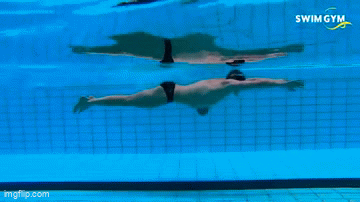
We want to make sure that you have the best swimming technique for your race! Here is what you can focus on so you can achieve proper form. Combine these tips and you will see an increase in your swimming speed.
1 | Body Position
Keep your body in a horizontal position with the waterline at your forehead. Your body should be flat and streamlined to minimize drag.
Maintain a slight downward slope from your head to your feet. This position helps reduce resistance and allows you to glide more efficiently between strokes.
2 | Arm Movement
The arm stroke in breaststroke consists of three phases: Outsweep, Insweep, and Recovery.
1 | Outsweep: Start with your arms fully extended in front of you, palms facing down. Sweep your hands outward slightly wider than your shoulders, keeping your elbows high.
2 | Insweep: Turn your palms inward, bend your elbows, and pull your hands back towards your chest in a circular motion. Your hands should meet under your chin, forming a “heart shape.”
3 | Recovery: After the insweep, quickly extend your arms forward to the starting position, keeping your head down and body streamlined.
3 | The Kick
The breaststroke kick is often called the frog kick because it mimics the motion of a frog’s legs. If you can have a swim coach help guide you through the kick.
1 | Bend: Bend your knees and bring your heels towards your buttocks, keeping your knees close together.
2 | Outward Thrust: Flex your feet outward and push your legs backward in a circular motion, using the soles of your feet to press against the water.
3 | Snap and Glide: Snap your legs back together forcefully, straightening them with pointed toes to maximize propulsion. This kick provides the main thrust in breaststroke swimming.
4 | Timing and Coordination
Proper timing is critical in breaststroke to ensure smooth and efficient movement through the water.
The Pull-Kick-Glide Sequence is the rhythm you should follow:
Pull: Start the arm pull while your legs remain extended.
Kick: As your hands move towards your chest, begin the kick.
Glide: Once the kick is completed, glide with your body fully extended before beginning the next stroke. The glide phase is essential to maximize propulsion and minimize drag.
5 | Breathing Technique
Breathing in breaststroke is typically done during the insweep phase of the arm movement.
Lift your head as your hands pull towards your chest, inhaling quickly through your mouth. As you extend your arms forward, exhale smoothly underwater. Keeping the head low when breathing minimizes drag.
6 | Common Mistakes to Avoid
Poor Body Position: Lifting your head too high during breathing can cause your hips to drop, increasing drag. Keep your head low and aligned with your body.
Incorrect Kick: An ineffective kick, such as separating your knees too far apart or not completing the snap at the end of the kick, reduces propulsion.
Timing Issues: Failing to coordinate the pull-kick-glide sequence disrupts the flow of the stroke. Ensure that your arms and legs move in sync.
Know What Works For You
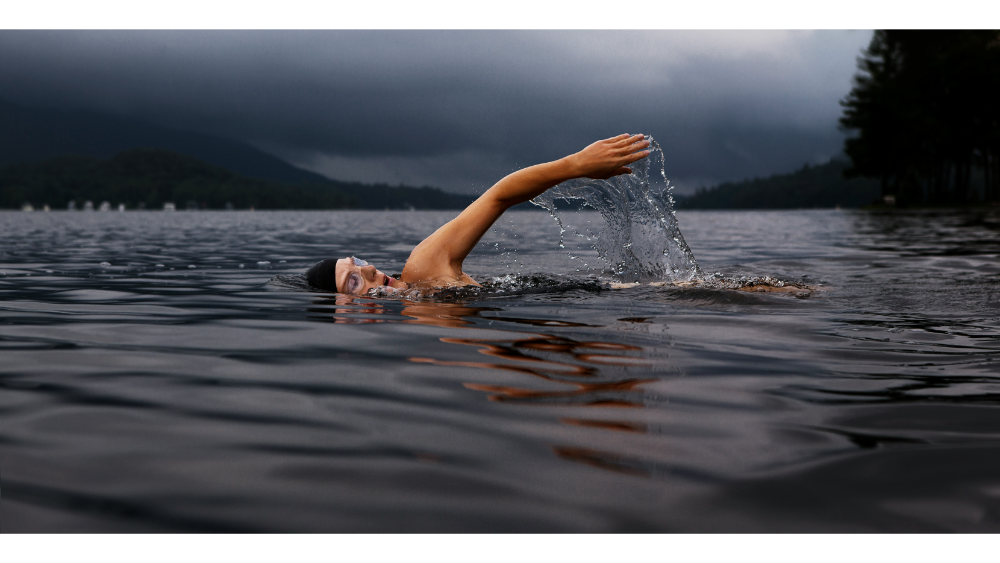
While most Ironman athletes favor freestyle, there is no one-size-fits-all answer when it comes to the best stroke for every swimmer. Freestyle offers faster times and smoother navigation in open water, but breaststroke provides better visibility, easier breathing, and a more relaxed pace that can be ideal in challenging conditions or during moments of fatigue.
Try Both Strokes
If you’re new to open-water swimming or the Ironman race, try both strokes during your training sessions. Use freestyle for the majority of your swim to build speed and endurance, but practice breaststroke to find out if it helps you regain composure or navigate better in rough conditions. By alternating between the two, you can discover which stroke feels most natural, which allows you to conserve energy, and gives you confidence in the water.
Every swimmer is different, and the key to success is finding what works best for you. So, head to the pool or open water, experiment with both strokes, and see which one aligns with your comfort level, endurance, and overall race strategy.
Frequently Asked What Kind of Swimming Stroke Ironman Questions
What is the best swimming style for Ironman?
Freestyle is widely regarded as the best swimming style for Ironman races due to its speed and efficiency, allowing athletes to cover long distances in a shorter amount of time.
What is the ideal stroke rate for an Ironman?
The ideal stroke rate can vary from 40 to 70 strokes per minute depending on the racer and the conditions on race day. A lower stroke rate focuses on more powerful strokes to maintain speed and minimize fatigue.
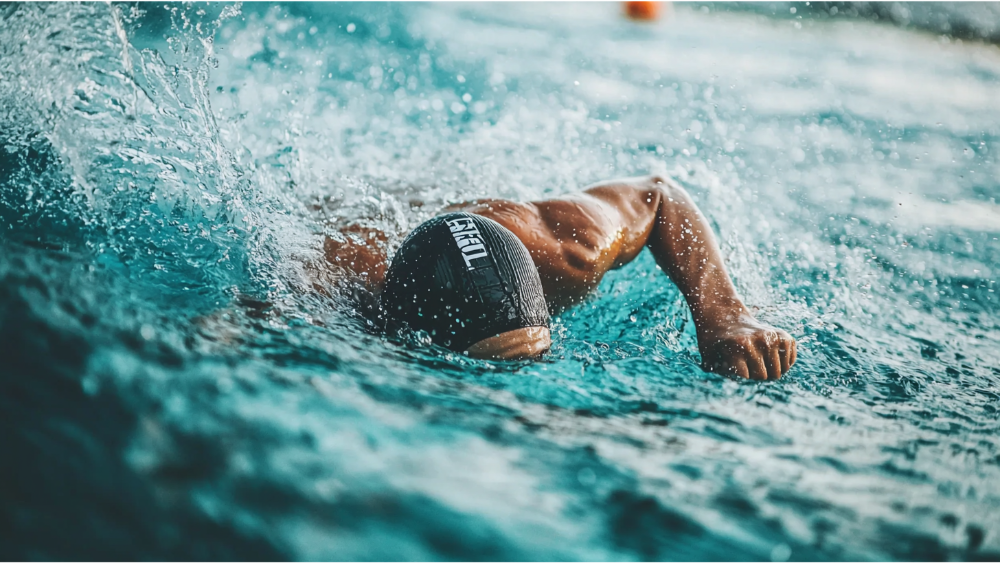
Leave a Reply